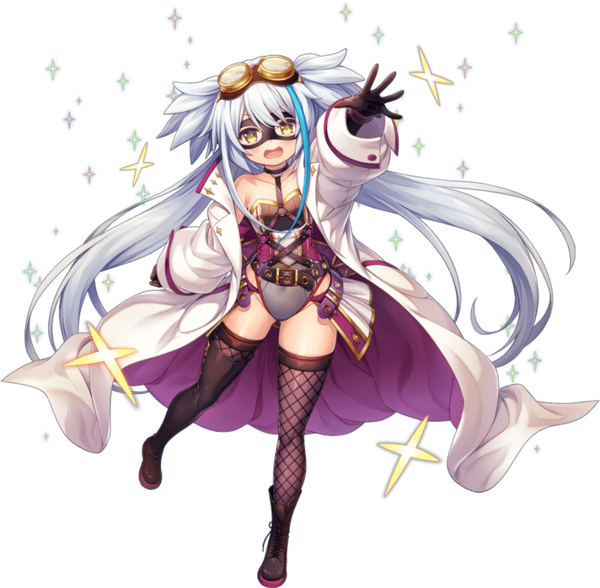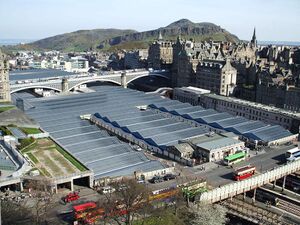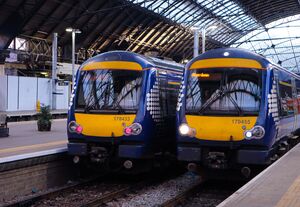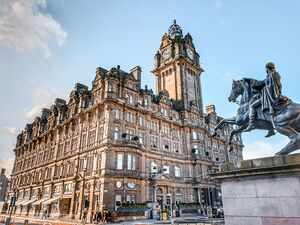Dr. Gloria
| Dr. Gloria | |||||
|---|---|---|---|---|---|
| Japanese Name | Dr.グローリア | ||||
| Weapon | |||||
| Race | Human | ||||
| Nationality | |||||
| Birthday | March 14 | ||||
| Constellation | Pisces | ||||
| Talents | Inventing | ||||
| Likes | Research, Inventions, Family | ||||
| Dislikes | Caterpillars, Studies that do not pique her interest, Bitter food | ||||
| Strengths | Intellect of a genius, Kind-hearted | ||||
| Weaknesses | Intellect of a genius yet stupid, Kind-hearted despite being a villain | ||||
| Hobbies | Researching, Inventing, Taking over the world | ||||
Eh, self introductions? Guess it's necessary, we don't know anything about each other, do we? Doctor is uh, umm, the leader of the Doggan Gang, and before that was mummy's――Uhh~? F-For the time being, 'I really really love my Big Brother!' is enough for you to know♪
Layers
| Icon | Title | Release Date | Where to Obtain |
|---|---|---|---|
| [Genius Little Inventor] Dr. Gloria | 2022 October 7 | [Training Camp - Dr. Gloria] Event Reward | |
| [Little Sis is a Genius Girl] Dr. Gloria | 2022 October 1 | [Little Doctor and the Magical(Physical) Big Sis] Event Reward | |
| [Otherworld's Genius Inventor] Dr. Gloria | 2022 September 30 | 2nd Anniversary Limited Gacha 3 | |
| [Extraordinary Pampered Girl] Dr. Gloria | 2023 March 31 | 2.5 Anniversary Limited Gacha 3 |
Obtained Skills
Profile
Main Story
| Story Arc 1 |
|---|
|
Dr. Gloria is the self proclaimed evil genius and mad scientist of the Doggan Gang faction, where all of her members are mass-produced robots, with the exception of her two sidekicks, Whisper and Bright, who she sees as her children. Other than her robotic goons, she is able to invent new gizmos very quickly. The inventions created by Dr. Gloria often look unremarkable with silly names, but are incredibly powerful with seemingly impossible high-level magic, such as reversing time, or creating a semi-working copy of the Mist Train after just one visit to the Mist Train's interior, to the surprise of the protagonist's team, as the Mist Train could not be reverse engineered by even the top scientists on the SSS. She frequently slips up calling the conductor as her "brother", and stated that she has waited for the conductor for a very long time. However the Conductor is never aware of having any other relatives aside from his mother, who went missing, and the amount of time missing does not match up to Dr. Gloria's appearance, and he is amazed by how much information she knew about him and his mother in contradiction to the former. Dr. Gloria's real name is later revealed to be Edinburgh in the Dark Academy Saga, but this information is only known by Paddington while investigating the alternate universe's records of Dr. Gloria's interrogation by the SSS. Dr. Gloria also indirectly revealed to Paddington that she is not from this universe of Iris Cloud, and her original home was on Earth, noted that things like the Internet, electromagnetic pulses, telegrams, walkie talkies and Jesus Christ do not exist in Iris Cloud. The Dark Academy was a discarded, failed prototype of the superweapon - Kochuten that was commissioned by Ricardo Trevithick which Dr. Gloria did not share the information of, until much later to the Conductor as he tries to undo and shut down the operating system of the remade, working version of Kochuten. Gloria begged the Conductor to help save their mother from suffering, noted that she may have went insane, before she, the Doggan Gang, and Luxor was arrested and sent to Oshioki Prison to face trial. |
Trivia
- Dr. Gloria's ability to create a fake Mist Train that has semi-reliable functionality references Wylam Dilly, the second oldest surviving railway locomotive in the world. The train was presented to the Edinburgh Museum of Science and Art in 1883, now called the National Museum of Scotland, where it is currently on display.
- Dr. Gloria stated that people often compared her to Alexander Graham Bell when asked about her intellect. Alexander Graham Bell is the inventor of the first telephone, and his birthplace is in Edinburgh, Scotland.
- The building in the background of [Otherworld's Genius Inventor] is the entrance of Edinburgh Waverley Railway Station, alongside Balmoral Hotel behind the building, formerly linked, it gives pedestrian access to Waverley Station to the south.
Counterpart
Edinburgh Waverley railway station is the principal station serving Edinburgh, Scotland. It is the second busiest station in Scotland, after Glasgow Central. It is the northern terminus of the East Coast Main Line, 393 miles 13 chains (393.16 miles; 632.7 kilometres) from London King's Cross, although some trains operated by London North Eastern Railway continue to other Scottish destinations beyond Edinburgh. Waverley station is situated in a steep, narrow valley between the medieval Old Town and the 18th century New Town.
Princes Street, the premier shopping street, runs close to its north side. The valley is bridged by the North Bridge, rebuilt in 1897 as a three-span iron and steel bridge, on huge sandstone piers. This passes high above the station's central section, directly over the central booking hall (which cleverly hides one of the main stone piers within its bulk). Waverley Bridge lies to the west side of the station (though platforms extend below it) and it is this road which, by means of ramps, formerly afforded vehicular access to the station and still provides two of the six pedestrian entrances to the station. The valley to the west, formerly the site of the Nor Loch, is the public parkland of Princes Street Gardens.
British Rail brought railway electrification in 1991 with electric trains on the East Coast Main Line to Glasgow Central and via York to London King's Cross. The station's large size and the unusual topography of its surroundings mean that it contains a large amount of valuable, centrally located land.
During 2006 and 2007, parts of Waverley were extensively refurbished, including two new through platforms and the electrification of platforms 12 to 18 in preparation for electric trains from the Airdrie-Bathgate Rail Link and future lines in Scotland to be electrified by the EGIP (Edinburgh/Glasgow Improvement Project). From 2010 to 2012, the glazing of the roof of Waverley station was entirely replaced with new strengthened clear glass panels, replacing the old 34,000 m2 (370,000 sq ft) of mixed surfaces including felt, cloudy wired glass and plastic sheet. Part of a £130 million upgrade, this has greatly increased the amount of natural light in the station.
As at other large railway stations of the Victorian and Edwardian eras, the railway company constructed a grand station hotel beside their station. The North British Hotel, adjacent to the station at the corner between Princes Street and North Bridge (on the site of the coachworks), opened in 1902. In 1983, British Rail sold it to the Forte hotel group. In 1988, Forte closed the hotel for a year to extensively remodel and update what had become something of a faded jewel. When it reopened, it was rechristened The New Balmoral Hotel, maintaining the NB initials in what has proved to be an astute marketing move, despite the hotel being 115 miles (185 km) from Balmoral Castle; subsequently, New was dropped from the name. The hotel enjoys commanding views over central Edinburgh and is one of the most luxurious and expensive hotels in the UK. There is no longer a direct entrance from the station. Wikipedia
The Balmoral Hotel, originally built as the North British (Railway Station) Hotel, is a luxury hotel and landmark in Edinburgh, Scotland. It is located in the heart of the city at the east end of Princes Street, the main shopping street beneath the Edinburgh Castle rock, and the southern edge of the New Town. It is accessed from Princes Street, on its north side, and flanked by North Bridge and Waverley Steps. The latter gives pedestrian access to Waverley Station to the south, to which in was formerly linked. Resulting from a competition in 1895, the hotel originally opened as the North British Station Hotel on 15 October 1902. The site, 52 North Bridge, was previously the location of pharmacists Duncan, Flockhart and company; William Flockhart supplied surgeon Doctor (later Sir) James Young Simpson with the first chloroform anaesthetic, which he tried on himself at his home 52 Queen Street, Edinburgh in 1847, and became standard practice in childbirth.
The building's architecture is Victorian, influenced by the traditional Scottish baronial style. It was designed by architect William Hamilton Beattie and for most of the 20th century it was known as the North British Hotel or the N.B., a traditional railway hotel built for the North British Railway Company adjacent to their newly rebuilt Waverley station. While under railway ownership, the hotel had porters in red jackets who would take passengers and their luggage directly into the hotel via a lift. Ownership passed into the hands of the London & North Eastern Railway (LNER) in 1923. After nationalisation of the railways in 1948, the hotel became part of British Transport Hotels until it was privatised and purchased by The Gleneagles Hotel Company in 1983.
The Balmoral Clock Tower is maintained by the Scottish clockmakers James Ritchie & Son since 1902, the hotel's clock is set three minutes fast to ensure the people catch their trains. The only day it runs on time is 31 December (Hogmanay), for the city's New Year celebrations. The hotel elected to change that for 2020, citing a desire to have three minutes less of that year. The tower, at 190 feet (58 m) high, is a prominent landmark in Edinburgh's city centre.
Map
Gallery
- Pages using Tabber parser tag
- Pages using DynamicPageList3 parser tag
- Weapon Gun
- Human
- St. Iris
- Pisces
- Element Pierce
- Element Fire
- Element Dark
- Element Water
- Element Light
- Train Knights
- Doggan Gang
- Scotland






















